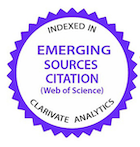Multisystem infection by Dipetalonema spp. in a capuchin monkey (Sapajus nigritus)
DOI:
https://doi.org/10.1590/1809-6891v24e-75264EAbstract
The capuchin monkey (Sapajus nigritus) is one of the primates that make up the wild fauna of Rio Grande do Sul. Like other wild animals, primates suffer from infectious diseases transmitted by insects, including filariasis. This report presents the anatomopathological aspects of a multisystemic infection by Dipetalonema spp. in a capuchin monkey, female, adult, of wild origin, rescued along a highway in the north of the state of Rio Grande do Sul by the road policing service and taken for assistance. In the clinical evaluation, nystagmus and involuntary head movements, semi-comatose state, hyperthermia (38.7ºC), hypovolemia, multiple abrasions and deep skin lacerations covering muscle layers were observed. The patient was hospitalized and medicated, but his clinical picture worsened, which resulted in death. At necropsy, the main findings were in the peritoneal cavity, where there was an accumulation of yellowish serous fluid, marked formation of fibrinous adhesions and numerous free nematode parasites in the cavity. Histologically, microfilariae have been observed in the lumen of blood vessels in the lung, liver, heart, kidneys, spleen, small and large intestines, and brain. Peritonitis, pneumonia and bronchiolitis associated with nematodes, liver damage and cerebral microgliosis with satellitosis, neuronophagia and hemorrhagic malacia were also observed. Adult microfilariae and filarids were submitted to morphometric identification and characterized as belonging to the genus Dipetalonema. Thus, it was concluded that this was a case of multisystemic infection by Dipetalonema spp..
Keywords: wildlife animal; dipetalonemosis; microfilaria; parasite; monkey
Downloads
References
Hass G, Printes RC. Levantamento populacional de Alouatta clamitans Cabrera, 1940 e de Sapajus nigritus (Godfuss, 1809) em fragmentos de mata com araucária, Caxias do Sul, Rio Grande do Sul, Brasil. A Primatologia no Brasil. 2014;13: 64-78.
Slomp DV, Prestes MX, Printes RC. Primatas em áreas protegidas do Rio Grande do Sul, Brasil: implicações para sua conservação. A Primatologia no Brasil. 2014;13:45-63. Disponível em: https://doi.org/10.13140/2.1.2779.4882
Lopes S, Calegaro‐Marques C, Klain V, Chaves ÓM, Bicca‐Marques JC. Necropsies disclose a low helminth parasite diversity in periurban howler monkeys. American Journal of Primatology. 2022;84 (1):e23346. Disponível em: https://doi.org/ 10.1002/ajp.23346
Zárate-Rendón DA, Salazar-Espinoza MN, Catalano S, Sobotyk C, Mendoza AP, Rosenbaum M, Verocai G. Molecular characterization of Dipetalonema yatesi from the black-faced spider monkey (Ateles chamek) with phylogenetic inference of relationships among Dipetalonema of Neotropical primates. International Journal for Parasitology: Parasites and Wildlife. 2022;17:152-157. Disponível em: https://doi.org/10.1016/j.ijppaw.2022.01.005
Notarnicola J, Jiménez FA, Gardner SL. A new species of Dipetalonema (Filarioidea: Onchocercidae) from Ateles chamek from the Beni of Bolivia. Journal of Parasitology. 2007;93(3):661-667. Disponível em: https://doi.org/10.1645/GE-962R1.1
Notarnicola J, Pinto CM, Navone GT. Host occurrence and geographical distribution of Dipetalonema spp.(Nematoda: Onchocercidae) in Neotropical monkeys and the first record of Dipetalonema gracile in Ecuador. Comparative Parasitology. 2008;75(1):61-68. Disponível em: https://doi.org/10.1654/4284.1
Eberhard ML, Lowrie JRC, Orihel TC. Development of Dipetalonema gracile and D. caudispina to the infective stage in Culicoides hollensis. Journal of Parasitology. 1979;65:89-95. Disponível em: https://doi.org/10.2307/3280209
Conga DF, Mayor P, Furtado AP, Giese EG, Santos JN. Co-infection with filarial nematodes in Sapajus macrocephalus and Cebus albifrons (Primates: Cebidae) from the Peruvian Amazon. Journal of helminthology. 2019;93(3):375-378. Disponível em: https://doi.org/ 10.1017/S0022149X18000287
Illia G, Jouliá RB, Citon L, Oklander L, Kowalewski M. Parasites and Other Infectious Agents in Non-human Primates of Argentina. Current Tropical Medicine Reports. 2022:1-11. Disponível em: https://doi.org/ 10.1007/s40475-022-00277-2
Corrêa P, Bueno C, Soares R, Vieira FM, Muniz-Pereira LC. Checklist of helminth parasites of wild primates from Brazil. Revista Mexicana de Biodiversidad. 2016;87(3):908-918. Disponível em: https://doi.org/10.1016/j.rmb.2016.03.008
Bueno MG, Catão-Dias JL, Laroque PO, Vasconcellos SA, Ferreira Neto JS, Gennari SM, Ferreira F, Laurenti MD, Umezawa ES, Kesper N, Kirchgatter K, Guimarães LO, Pavanato HJ, Valença-Montenegro MM. Infectious diseases in free-ranging blonde capuchins, Sapajus flavius, in Brazil. International Journal of Primatology. 2017;38:1017-1031. Disponível em: https://doi.org/10.1007/s10764-017-9994-5
Strait K, Else JG, Eberhard ML. Parasitic diseases of nonhuman primates. In: Abee CR, Tardif SD, Morris T, Timothy M, eds. Nonhuman Primates in Biomedical Research. 2nd ed. New York, NY: Academic Press, 2012;197–298.
Emmerich T, Evangelista C, Galindo C, Lunardeli B, Gonzaga Junior LC, Traverso SD. Ocorrência de Dipetalonema gracile em bugios ruivos (Alouatta guariba) no estado de Santa Catarina. Archives of Veterinary Science. 2013;18(3):482-483.
Ramalho AC, Vieira RFC, Bacalhao MBM, Kakimori MTA, Vieira TSWJ, Guerra MVSF, Lucena RB, Oliveira JB, Guerra RR. First report of Dipetalonema gracile in a captive Marcgrave’s capuchin monkey (Sapajus flavius) in northeastern Brazil: Scientific communication. Semina: Ciências Agrárias. 2022;43(2):883-888. Disponível em: https://doi.org/10.5433/1679-0359.2022v43n2p883
Moore J, Freehling M, Horton D, Simberloff D. Host age and sex in relation to intestinal helminths of bobwhite quail. The Journal of Parasitology. 1987;73(1):230-233. Disponível em: https://doi.org/10.2307/3282375
Magnis J, Lorentz S, Guardone L, Grimm F, Magi M, Naucke TJ, Deplazes P. Morphometric analyses of canine blood microfilariae isolated by the Knott’s test enables Dirofilaria immitis and D. repens species-specific and Acanthocheilonema (syn. Dipetalonema) genus-specific diagnosis. Parasites & Vectors. 2013;6(1):1-5. Disponível em: https://doi.org/10.1186/1756-3305-6-48
Sazmand A, Eigner B, Mirzaei M, Hekmatimoghaddam S, Harl J, Duscher GG, Fuehrer H-P, Joachim A. Molecular identification and phylogenetic analysis of Dipetalonema evansi (LEWIS, 1882) in camels (Camelus dromedarius) of Iran. Parasitology Research. 2016;115:1605-1610. Disponível em: https://doi.org/10.1007/s00436-015-4896-y
Conga DF, Mayor P, Furtado AP, Giese EG, Santos JND. Occurrence of Dipetalonema gracile in a wild population of woolly monkey Lagothrix poeppiigii in the northeastern Peruvian Amazon. Revista Brasileira de Parasitologia Veterinária. 2018;27:154-160. Disponível em: https://doi.org/10.1590/s1984-296120180014
Vanderhoeven E, Notarnicola J, Agostini I. First record of Dipetalonema robini petit, Bain & Roussilhon 1985 (Nematoda: Onchocercidae) parasitizing Sapajus nigritus in northeastern Argentina. Mastozoologia Neotropical. 2017;24(2):483-489. Disponível em: http://sedici.unlp.edu.ar/handle/10915/82077
Conga DF, Mayor P, Giese EG, Santos JN. First report of filarial nematodes in free-living pitheciid primates. Systematic Parasitology. 2019;96:257-264. Disponível em: https://doi.org/10.1007/s11230-019-09838-y
Laidoudi Y, Lia RP, Mendoza-Roldan JA, Modrý D, Broucker CA, Mediannikov O, Davoust B, Otranto D. Dipetalonema graciliformis (Freitas, 1964) from the red-handed tamarins (Saguinus midas, Linnaeus, 1758) in French Guiana. Parasitology. 2021;148(11):1353-1359. Disponível em: https://doi.org/10.1017/S0031182021000901
Shaffer CA, Milstein MS, Lindsey LL, Wolf TM, Suse P, Marawanaru E, Kipp EJ, Garwood T, Travis DA, Terio KA, Larsen PA. “Spider monkey cotton”: bridging Waiwai and scientific ontologies to characterize spider monkey (Ateles paniscus) filariasis in the Konashen Community Owned Conservation Area, Guyana. International Journal of Primatology. 2022;43(2):253-272. Disponível em: https://doi.org/10.1007/s10764-021-00272-w
Milstein MS, Shaffer CA, Lindsey LL, Wolf TM, Suse P, Marawanaru E, Kipp EJ, Garwood T, Travis DA, Terio KA, Larsen PA. Integrating indigenous knowledge, ontology, and molecular barcoding to characterize spider monkey (Ateles paniscus) filariasis. BioRxiv. 2020:1-29. Disponível em: https://doi.org/10.1101/2020.10.26.354985
Plesker RA. Dipetalonema Gracile - Infection in a Squirrel Monkey (Saimiri sciureus). Primate Report. 2002;63:1-3.
Lopes S, Calegaro‐Marques C, Klain V, Chaves ÓM, Bicca‐Marques JC. Necropsies disclose a low helminth parasite diversity in periurban howler monkeys. American Journal of Primatology. 2022;84(1):e23346. Disponível em: https://doi.org/10.1002/ajp.23346
Gozalo A, Montoya E. Mortality causes of the moustached tamarin (Saguinus mystax) in captivity. Journal of Medical Primatology. 1992;21(1):35-38. Disponível em: https://doi.org/10.1111/j.1600-0684.1992.tb00623.x
Boyd JW. The mechanisms relating to increases in plasma enzymes and isoenzymes in diseases of animals. Veterinary Clinical Pathology. 1983;12(2):9-24. Disponível em: https://doi.org/10.1111/j.1939-165x.1983.tb00609.x
Narama I, Miura K, Tsuruta M, Tsuchitani M. Microfilarial granulomas in the spleens of wild-caught cynomolgus monkeys (Macaca fascicularis). Veterinary Pathology. 1985;22(4):355-362. Disponível em: https://doi.org/10.1177/030098588502200410
Published
How to Cite
Issue
Section
License
Copyright (c) 2023 Brazilian Animal Science/ Ciência Animal Brasileira

This work is licensed under a Creative Commons Attribution 4.0 International License.
Authors who publish with this journal agree to the following terms:
- Authors retain copyright and grant the journal right of first publication with the work simultaneously licensed under a Creative Commons Attribution License that allows others to share the work with an acknowledgement of the work's authorship and initial publication in this journal.
- Authors are able to enter into separate, additional contractual arrangements for the non-exclusive distribution of the journal's published version of the work (e.g., post it to an institutional repository or publish it in a book), with an acknowledgement of its initial publication in this journal.
- Authors are permitted and encouraged to post their work online (e.g. in institutional repositories or on their website) prior to and during the submission process, as it can lead to productive exchanges, as well as earlier and greater citation of published work (See The Effect of Open Access).































